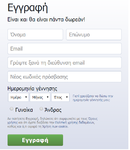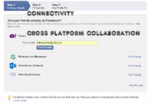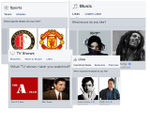|
|
| (43 intermediate revisions by the same user not shown) |
| Line 1: |
Line 1: |
| [[File:800px-User Profile Info Model.png|222x222px|framed|right|user profile info model]] | | [[File:800px-User Profile Info Model.png|150x150px| user profile info model]] |
| [[File:Fbprofile.png|222x222px|framed|right|Providing your birthday helps make sure you get the right Facebook experience for your age]] | | [[File:Fbprofile.png|150x150px|Providing your birthday helps make sure you get the right Facebook experience for your age and its free]] |
| [[File:cross.png|160x152px|framed|right|integrity]] | | [[File:cross.png|150x152px|cross platform integrity]] |
|
| |
|
| '''user profile'''
| |
|
| |
|
| User profile is supposed to digitaly represent one s identity, but it is '''forming''' and constructing the individual, particularly in the online world. As a media object it talks about identity curation and construction, power and control, social hierarchies.As a collection of settings and structured metadata it documents the users identity while forming it through the selection from a limited range of choices and provides a template for exercise of control between corporation and their user and among users themselves.
| |
| --
| |
|
| |
|
| According to '''Microsoft''', "your user profile is a collection of settings that make the computer look and work the way you want it to. It contains your settings for desktop backgrounds, screen savers, pointer preferences, sound settings, and other features. User profiles ensure that your personal preferences are used whenever you log on to Windows. A user profile is different from a user account, which you use to log on to Windows. Each user account has at least one user profile associated with it."
| |
|
| |
|
| According to '''Facebook''', "Your profile, is your collection of the photos, stories and experiences that tell your story. Your profile also includes your Timeline". This definition can be found in their Glossary of Terms, where other interesting approaches can be found (what is a friend?Friends are people you connect and share with on Facebook and what is a list?Lists are an optional way to organize your friends on Facebook. )
| | SCREENSHOTS FB |
| | | [[File:Fba.png|150px|]] |
| --
| | [[File:Fbaa.png|150px|]] |
| | | [[File:Fbaaa.png|150px|]] |
| A user profile is a '''collection of collections'''. Collections of settings , of metadata associated with a specific user ,collections of photos, etc. .It is supposed to ensure authentication , permissions, rights, and maintainance of personal preferences. It differs from a user account, beeing a more public expression of it. However, in order one to create a profile, must create an account
| | [[File:Fbaaaa.png|150px|]] |
| | | [[File:Fbaaaaa.png|150px|]] |
| This '''process''' of building ones user profile beginns indeed with an account creation(registration ),accepting terms of services, and verification (via personal email),and later on moves to public profile construction, adjusting personalised settings and filling personal information in existing categories.
| | [[File:Fbaaaaaa.png|150px|]] |
| | | [[File:Fbaaaaaaa.png|150px|]] |
| The design model of the user profile is the one of the '''database.''' Moreover this database driven formation of the online profile is happening within online structures that are themselves databases.
| | [[File:Fbaaaaaaaaaaaaaaaaa.jpg|150px|]] |
| | |
| It seems that identity and database have a structural relationship in the world of user profiles. According to '''Mark Poster''', because of its structure contitutes individuals by manipulating bits of information . This illustrates how an identity is formed within a user profile: through language , data entries and the relationships formed among data within the database.
| |
| | |
| User profiles are '''linguistic constructions''', which occur in very linguistic structures, starting from the source code of websites we use to computers as linguistic devices and our linguistic-textual participation)
| |
| | |
| '''MEDIATES'''
| |
| | |
| Profile is a '''linguistic construction that mediates a social construction''': one;s identity/ies. By providing a very controled space and using controled vocabulary puts the individual in the position to enter data in the database that will regenerate the persons identity in the context of that system. This linguistic construction mediates at the same time the choices of the individual alltough they are hosted in very simplistic and restricting forms and they are not endless choices but choices from a list.>>> The use of these choices, from food preferences to the choices that affect what kind of data we contribute, show that our user profiles mediate also a '''controled curation of identity.''' It is this controlled curation that illustrates the technolibertarian utopias related to identity exploration and alternative identities.
| |
| | |
| It also mediates the concept of '''personalisation/ customisation'''. Making (computer) systems more "friendly" to the users. In response to the notion of the invisible user, user profile nowadays can mediate the users' invisibility.
| |
| | |
| User profile assigns also that identity with specific regulations , duties and rights predetermined, therefore mediates '''power relations and control.''' These relationships are formed not only between the institution/corporation and the user but even among users themself. A feature of facebook, the report of a user, is examplary of that. Again this relationships can be traced as well within one's self: one of one;s identities controling another.Furthermore, power and control are based on the practise of one '''documenting''' him/herself while creating all this accounts and profiles. From a preselected range of choices, understandable from computers, one is documenting in a written record him self by self-classification and data entering. The public side of the record is visible when the profiles are active. But when they get deactivated or deleted or reported then the social networking company is the only one who has in its hands the documentation record.
| |
| | |
| It also mediates certain '''hierarchies''', within society and within one 's self. In order to create a profile in a social network for example one has to be present through ones account in an operating system, lets say Windows. And reversed, ones online profiles lead back to ones profile in the operating system. Maintaining profiles in operating systems involves again hierachies, by distinguishing administrators by user and assigining specific regulations or rights to them. In the online context, the administrator of our profiles becomes the webservice providor, the corporation.
| |
| | |
| '''(NICK)NAME, PROFILE PICTURE, EMAIL'''
| |
| | |
| (nick)Name.
| |
| The history of chatrooms, forums and social networking sites proves that the "real" name of a user is not always needed in the formation of ones profile. But even this doesnt prevent users from beeing exposed to companies as the ip and the digital traces seem to be more important than names. New name policies like facebook's for example became really restrictive with the use of names, while its interesting to observe the differencies in policies from lets say fb to google+, and the importance of users feedback in this decisions_+article google+ and identity. In come cases usernames and names given in the account creation are the same but not always.+fb names, alternative name etc. Particularly in facebook, an interesting feature that corresponds and is promoted to host "alternative" identities, nicknames, stagesnames is the one of tha funpages. +funpages-categorisation--liking
| |
| | |
| '''Portrait''' is a very visual but also psychological concept that can be found in any kind of art and includes normally a face and its charakteristics. In modern society , portrait relates with photography as a means to understand , monitor and document the world and the individual. '''Gallison and Daston''' in their book Objectivity comment on the relation of the lense(from microscopes to cameras) with scientific objectivity, which they see a the suppression of some aspect of the self. Moreover, '''Evi Sambanikoy''' writes about the photographer as the reporter of the objectified subject. Here i m interested in the majority of users that make use of photographic portraits and not drawing/paintings ,+ source
| |
| | |
| Our portraits in our user profiles are our profile pics. The selfie corresponds to the "democratisation" of the use of the camera by individuals and appears succesfull in motivating people document themselves online.'''Ludovico and Cirio''', in their "facetofacebook:smiling in the eternal party" refer to the face as the viewpoint as a major point of reference in the world, stronger even than names .They also argue that facebook profiles are so effecting in representing real people through a a specifi element:the profile picture.
| |
| | |
| E mail is used here in order to offer the company a "verification" that we are humans and that we consiously create our profile.
| |
| It is also used in order to extract data about our emailing list and to force connectivity from the beginning of our profile life.
| |
| | |
| '''USER PROFILES IN OPERATING SYSTEMS'''
| |
| | |
| | |
| '''USER PROFILES IN SOCIAL NETWORKING'''
| |
| (οr layering -operating to social ntw)
| |
| | |
| facebook + API +
| |
| categorisation and metadata
| |
| profiles and fanpages
| |
| | |
| -- how it mediates all above
| |
| | |
| [[File:Fb1.png|120x112px|framed|none|]] | |
| | |
| [[File:Fbb.png|120x112px|framed|center|]] | |
| | |
| [[File:Fb3.png|120x112px|framed|right|]] | |
| | |
| [[File:Fb4.png|120x112px|framed|none|]] | |
| | |
| [[File:Fb5.png|120x112px|framed|center|]] | |
| | |
| [[File:Ff6.png|120x112px|framed|right|]] | |
| | |
| [[File:7.png|120x112px|framed|none|]] | |
| | |
| | |
| ''sources etc''
| |
| | |
| User authentication , mozilla persona.
| |
| Mark Poster, Foucault and the dabatase
| |
| Olga Goriunova lexture, what was the user
| |
| Computers as theater ?
| |
| Olia lialina-turing complete user lecture, The General Purpose User
| |
| Lev Manovich, How do you call a person who is interacting with digital media?
| |
| Don Norman
| |
| Al. Ludovico and Paolo Cirio.facetofacebook:
| |
| Sambanikou Evi
| |
| Daston and Galisson, Objectivity
| |
| http://private.artmuseum.pl/en/introduction
| |











